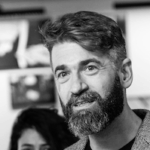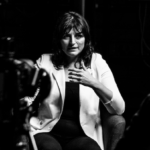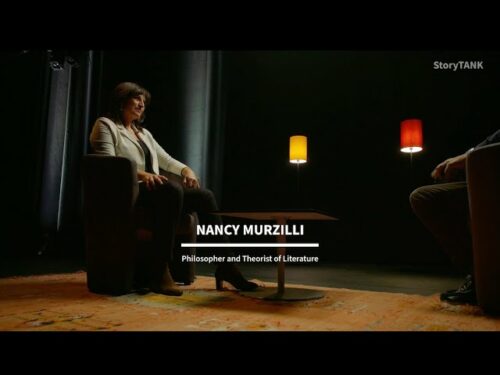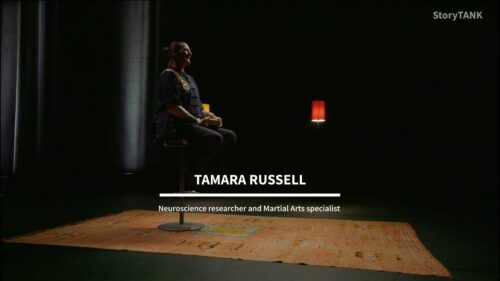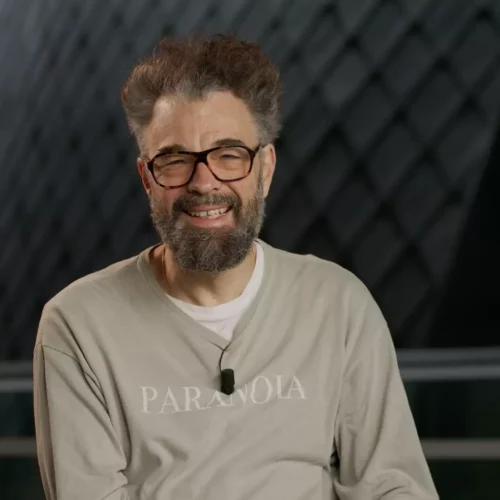Map the Imagination
Stories build complex worlds in which we find ourselves projected. In the footsteps of the “Theory of the Rhizome”, imaginary as a space of co-elaboration, a space of proliferation of possibilities…
With Bohdan Piasecki – Poet and Professor of Creative Writing, Nancy Murzilli – Philosopher and Literary Theorist, Anne Querrien – Sociologist and Urban planner and Manue Gaquère – Sports Teacher
— a conference recorded at Les Champs Libres (Rennes, Brittany) in December 2023 in the framework of the serie “What stories for our time”, moderated by Nicolás Buenaventura – writer-director and storyteller – and Yann Apperry – screenwriter, playwright and novelist.
Anne Querrien
« As Deleuze says so well in his book on painting in his lecture on Bacon: “Our imaginary is overrun with clichés, which we need to get rid of in order to create.” Mapping is another way of seeing the world, of following it, of philosophising… »

Narrative: a flow story.
In the teachings of Guattari or those of Lacan, creative workflows are highlighted that can be fluid, that “flow” but that can, very often get stuck. In French we say we “dry up”. We “dry up” or get stuck during exams, we get stuck on a poem, we block in our writing. So, we use cheat sheets to avoid these blocks. Generally, cheat sheets aren’t very useful, because it’s more a question of flow.
A mapping of the imaginary in the real.
The imaginary needs to be put in its place. There are the flows of reality… There’s the imaginary that, as Guattari says, creates existential territories. In fact, what we map out are certain real-life practices. And, if we’re stuck in these existential territories, we don’t create anything of interest, we create worthless stories, repetitive… Ritornellos.
Reality to feed the imagination.
Flow can take you beyond that, towards what Lacan calls: the symbolical. And what Guattari called: non-physical spheres. Which are music, maths, philosophy… all forms of collective human production, abstract collective productions. Guattari distinguished himself from Lacan, in saying all that draws on production, based on different technologies – the flow of successive technologies, machines which aren’t just technological – as in mechanical, made of metal, but also social, produced by humanity over time, inherited by all.
This is a quick resume but it’s necessary to provide this framework, because I’m sort of wary of narrative set exclusively in the imaginary. As Deleuze says so well in his book on painting in his lecture on Bacon: “Our imaginary is overrun with clichés, which we need to get rid of in order to create.” And it’s not that easy.
Heritage is an essential part of the story.
Regarding heritage, which is common to many, or for a family… for example, I have four sisters, we have the same family heritage, let’s say. In fact, often sidestepping occurs due to outside influences, not of our own making. What bothers me is, that everyone talks of stories as if they’re our own invention. For me they’re forged collectively between me and outside events.
Project the imaginary onto reality.
Deligny, was born in 1913 his father was killed in the 1914 war. So, he grew up without a father and became an educator for the young, initially delinquents then for increasingly for difficult autistic kids. He spent his last years in the Cévennes, with a young lad called Janmari. And when Janmari was brought to him, he drove everyone crazy because he spun round and round screaming. The father was unknown, it was the mother who brought him, so Deligny took him to the Cévennes to live with him because at the psychiatric clinic, la Borde, although very open, where this young man was brought, who, I think, was 8 at the time, no one could cope with him, his spinning round screaming. So, he goes to the Cévennes and is joined by a young man named Jacques Lin who he’d met near Paris, a draftsman at Hispano Suiza and he went to live there as an educator in this place for autistic children. Jacques Lin couldn’t cope with Janmari. So Deligny tells him: “Listen you can draw, every day you draw maps of his movements, not imaginary ones, his actual movements, maps of Janmari’s movements, and every time he spins and screams you draw a circle on the map.” After a while there were fewer and fewer circles on the map. And what Deligny told me was it didn’t mean that Janmari stopped spinning it meant that Jacques Lin was less irritated.
So, they established in their community a method of mapping the youngsters’ movements and made some interesting discoveries. For example, the autistic kids disappear, we don’t know where. And the educators obviously worry, where can they be, etc. Jacques Lin followed Janmari to do his maps, and they realised that Janmari was moving in ellipses around the adult living areas. There was an objective relationship, not an imaginary one, objective, between him and the group of adults looking after him. They also realised that when Janmari pooped like a dog on the ground, there was always water below. He became the community’s water diviner.
What I’m saying is that it’s not imaginary. It’s imaginary for others. We project onto reality what we imagine with different coordinates. I think that as a teacher we’re faced with these problems because students interpret what we say with their own stuff. Which has sometimes surprising results!

Map to unlock the story.
What a map can do, in my opinion, is to unblock characters. In fact, there is no confusion. And mapping, for example, and I’m probing here, to lay out this family territory over two, three, four, or five generations with the different characters, and their different points of view, and their different materiel frameworks, in which they lived.
Deploy the personal worlds of collective storytelling.
I’ll refer to my own experience, I was 2 years old, living in Guingamp. The toilet was at the back of the garden, not at all like the toilets here. So, when you experience this as a child it forges you differently to someone who has never seen toilets other than those of today. This trivial example is used a lot in Russian novels. Mapping is really about the unfolding of a world, what Guatarri called – he used it in Deleuze and Guatarri’s Kafka – arrangements of collective statements. Meaning, what is being articulated is a collective situation, it’s not just Bohdan alone, he’s just the scribe of a situation. And that’s already helpful because it explains a whole lot of divergences.
Mapping in the narrative, to go beyond the conventional wisdom.
Minor literature assumes that not everyone speaks the same language. People exchange in different languages and so, can exchange through the work of someone who maps or a scriptwriter, or a poet or whoever, who will sieve through all that and make something of it.
All Deligny’s work is on that. The young Janmari and other children Deligny helped, live outside the realm of language. For Lacan and the psychologists of the like, in mainstream thinking, humans are characterised by language. So, anything outside of language, is in the animal realm. So here was an opposing philosophical hypothesis which was that there are humans who don’t use language. Living with them, together we can shape this human, by using these maps which show, as I mentioned earlier, these children were considered as animals, running all over the place unaware of the adults around them. These maps prove the opposite they provide concrete evidence.
Mapping is a unique experience.
Mapping is not a set of IGN maps with their standardised categories. It’s not another model. It’s the monitoring of a person in proximity. And it’s not a model, there is no model. And it can’t be reproduced. Reproduction is out of the question. Each one is a unique experience – a psychoanalysis is unique for each individual. The big problem in psychoanalysis as, unfortunately, practiced in universities, is to have made models based on individual’s constructions. It’s another way of seeing the world, of following it, of philosophising…
Nancy Murzilli
« As in divinatory practices, these agentive fictions, in rearranging the visible, reveal the invisible. What world prefigures our conception of what is meant by the term fiction? »

The agentivity of fiction.
I’m interested in what I’ve called ordinary fictions and their performative nature. The performative nature of fictions, considering the performativity of fiction, we then have to consider their agentivity and also their political, even subversive potential. As in divinatory practices, these agentive fictions, in rearranging the visible, reveal the invisible. As a result, fiction is no longer confined to spheres of artistic production and lighthearted games. It is no longer a mimetic model reflecting our lives. It’s a system we all use in daily life for which these artistic practices prepare us.
Dare fiction to transform the existing.
We might take fictions for fantasies, they can even manipulate us. But I also think there’s an approach, a remedy to this illusion, which is to confront fiction head on, embrace it as such, and allow it to transform existing states.
For example, until I was almost 30, I believed my family came from Sicily, because my father told me our ancestors were Sicilian, the mafia and all. He loved all that. So, I grew up with this illusion. Until… Not at all, we came from a small village in the Abruzzes in Italy.
My family had immigrated simply because they were extremely poor. It wasn’t quite the same adventure. But ultimately, my foundations are built on fiction, on that illusion.
The political dimension of fiction.
And this is where I join Anne’s proposal: If fiction has an effect on us it implies a form of responsibility. We might question two aspects. Firstly, what world prefigures our conception of what is meant by the term fiction? Because, I believe, this engages the political dimension of fiction. Secondly, is fiction always the best means for changing the world?
Blurred boundaries between reality and narrative.
We perceive things from the outside things we don’t understand therefore, it seems it can’t be objective. But in fact, it’s also a form of reality. And I think fiction is also that. It’s a mix between reality and fiction. And maybe sometimes something which is in principle a fiction, can become reality because we’ve understood it.
We can avoid the question of belief in the permanence of the dead, or not, simply by focusing on what is important to us. And what is important is perhaps to keep communication going with them one way or another. To keep a narrative going with them.
Bohdan Piasecki
« Poetry invites plurality, it’s open for interpretation, it’s an invitation for emotional reactions, which often we can’t express verbally. »

The multiplicities of the narrative.
I come from the world of poetry. I write poems which sometimes can be classified as fiction, sometimes they’re more narrative. And in poetry I think that we often take refuge in this notion that we’re a bit different, that we don’t tell simple stories, we can hide behind the multiplicities, we can create systems putting the responsibility of interpretation, or finding meaning in the hands of the reader.
Question the narrative through the notion of inheritance.
But poems are texts like any other. I question poems as active texts, it’s tied to the question of heritage. What I try to write, even if it’s anecdotal at present, is a collection of poems related to my own heritage, to my family history:
My grandfather, whom I never knew, he died before I was born, in Poland, where I’m from, was, before the war, leader of the Polish fascist movement, the Polish nationalist far-right party. Which was prohibited by the pre-war government in Poland. Later my grandfather fought against the Nazis – I’ll skip the details – After the war, when Poland fell under Soviet Union influence he believed it was impossible to resist that influence. And he sought political power by positioning himself as a kind of intermediary between the Stalinist government, initially, and then with those who came after: the Polish right wing, essentially the Catholic Church. Just to say that that he had a lot of enemies.
And that… his eldest son, whom I was named after, at the age of 15, was kidnapped at the school entrance and was murdered. He was found a year later, stabbed to death in a cellar. I was born in 1980, in a war-torn Poland. My parents sent me to school in France. That’s why I speak French. And I grew up somewhat cut off, removed from this story.
But when I started university in Poland, I observed, when I said my name: I’m Bogdan Piasecki, the professors said: that’s interesting, there was a Bohdan Piasecki. It’s a well know story in Poland, because the criminal case was never resolved. The murderers’ names were never revealed, they were never caught. So, when I went to the cemetery, to visit my family tomb, I heard the people behind me with all their conspiracy theories: “Oh yes, that’s Piasecki, it’s that group which killed his son. He pretended to kill his son, it was all his own doing.” On top of that, is the fact that, if I see a far-right protest march in Poland now, some of the protesters are wearing the emblem of my grandfather’s organisation.
To clarify, I don’t have any affinity with his political ideas. But it’s my family and it’s my name. And I know that if I write anything on this topic, which has nothing to do with my poetry. Stories I’ve written as a poet they’ll be read because of who I am. And this sense of responsibility comes from that and also the interrogations.
The liberation of shared narrative.
What I write is poetry. Poems which say only one thing, tell one story, or which propose a simple political argument, are often not great poems. I don’t claim the right to be the moral compass for anyone. But at the same time, is this our role? We have to multiply meanings, or we should address aesthetics? How can we use this technology you mentioned – this poetic system I’ve inherited – to tell a story which needs to be heard? Using poetry, which is probably not the best form.
There’s a form of responsibility in that, with a story we feel needs to be told, which is trying to exist. The responsibility I can accept is the responsibility towards the story trying to emerge, trying to exist. Not necessarily a, let’s say, social responsibility… But I find a sort of arrogance in that, the world is waiting for me to repair it with my poems. I’ve been given or a world I know that no one else is knows, that’s a responsibility I can understand. There’s a poet and novelist, I think from Chile, called Alejandro Zambra, who was talking about his poems, and he said… I’ll paraphrase, I don’t remember the citation but he said: I don’t know if my poems are good but they have a right to breath. They must be brought to life. Are they good? I have no idea.
I hold onto that.

The author’s responsibility.
Because if we’re talking about responsibility, there are so many narratives intertwined from which I could extract a form of responsibility, it’s almost impossible to choose.
Who am I to be responsible? As a Polish? I haven’t lived in Poland for 17 years. I live in England. As an immigrant? It’s true there are often far-right wing movements among immigrants. There’s always a high risk of radicalization among Eastern European immigrants.
Responsibility as a poet? But towards whom? It’s very hard to identify. But I feel great responsibility towards the story, towards the words I choose to relate it. On a micro, not a macro scale, towards those I want to talk about, towards this boy, this 15-year-old Bohdan, who became a propaganda tool throughout Polish political spheres whose name resurfaces every 2 years but only in a crime context. Maybe he can become someone else, a more complex person, not so one-dimensional. I think it’s probably one of poetry’s strengths.
Should the story be definitive?
There’s a game I sometimes play with my students – I teach writing in England – I give them blocks of text, some are excerpts from novels, others are extracts from poems, I reformat them into paragraphs and I ask them to identify which are from novels or academic texts and which are poems. They always get it right. And when I ask: “how do you know?” It’s often because prose has a purpose, it aims to communicate something, either a story or some information. Poetry invites plurality, it’s open for interpretation, it’s an invitation for emotional reactions, which often we can’t express verbally. And it’s less definitive. And maybe we should head in this direction.
The complex choice of words to feel the story.
We were saying earlier that people don’t speak the same language and it’s presented as a problem. We imagine an ideal language shared by all. That’ll never happen. And as a translator I think the solution is not to aim for a single language to be shared by all, but to find value in the multiplicity of languages.
Even with words, what you’re describing is fantastic. Even with words I believe we can create freer spaces letting words “roll around on the floor”. To demand more from words than usual. And discover that their definitions can vary. There’s nothing new in what I’m saying, but perhaps for children, and even for us, we develop habits and they make us lazy with words, with language. That’s what poetry does, it demands more from a word than usual.
Maybe that’s what they do, in scriptwriting, in creating interaction between words and images. Stopping the words from time to time. We often do that with students: We can start by taking away the first words. If you’re writing about joy, you make a long list of words… Everything that makes you think of joy, make a long list of everything and you put it away… Then you say: “Now you write about joy but all those words are not permitted. You have to find other ones.”
But otherwise, and this goes back to this idea of a language. Living in England, with English as such a dominant language which doesn’t leave much room for others, I’ve written several poems in Polish for the English. They’re meant to be perceived not necessarily understood according to the way a dictionary might define it. More perceived I guess. Like music or dance.
Control of the body through the narrative.
Comme le dit Anne, la cartographie consiste à trouver des alliances transversales dans le récit avec d’autres domaines, disciplines, écosystèmes.
About finding those associations or recognizing that perhaps the categories we work within are too restrictive. I find that we tend to separate dance from writing. In my work, I write for voice a lot, for live performance. Poetry is physical. I’m here, in the present. My body is present. It’s not just words on a page. Even for poetry we read from a book.
There’s an American poetry critic, Robert Pinsky, who wrote a very short but very interesting book on sounds in poetry. In the introduction, he explains that for him, poetry is a dance, that to read a poem that someone else has written stirs the air column, activates the articulators. The poem takes control of your body. The difference being you’re not watching a professional dancer, they’re amateurs performing the poem’s dance. This is also interesting because he had a very democratic approach to poetry which I highly appreciate.
Manue Gaquère
« Using the body to relate this story they created collectively, surprise themselves. »

Feeding the story through the unknown.
Before coming, I reflected on the association between mapping and the imaginary. And I thought, in fact I would never have thought of associating them.
Mapping, when reflecting on it in regards to my young students, I thought of mapping as unfolding our personal story at a point in time. So, what does that mean for an 11-year-old, to map out their life up until their 11th year, with everything they’ve received from their parents, from the children they’ve grown up with, from their teachers. I wondered what the imaginary associated with mapping, for an 11-year-old, might that mean. Regarding the imaginary, sometimes I think there’s not much room left in the way of imaginary for children. That’s what I try to offer in my work particularly through dance.
I’d like to quote a theatre play called “I dance because I’m wary of words”. My question is: Can we tell stories, create narratives with elements other than words? My answer is, yes, of course. And this idea of mapping, what interests me with younger children who haven’t had much life experience is precisely about discovering unfamiliar territories. And from my position, it’s about how, as a teacher, do I implement the conditions which will allow these children to express themselves, be it through their bodies or through words. What can I do? What protocol, which creative process can I set up with these children to enable them to discover these territories and learn about themselves maybe?
Collectively invent a new world.
I can take a very recent exercise. I try to work with inter-disciplinarity using experiences they’ve had elsewhere, not with me. The children went to a story-telling festival called “The High Tide Festival” which takes place in Brest. And they saw a performance called “Le piment des squelettes”. And so, I began my dance cycle and started my lesson, the other day, telling a story with words a story I started to tell then they continued. They invented a whole new world taking it in turns to tell.
Translate the story, by the body.
So, the next lesson will be using the body to relate this story they created collectively. It’ll be an exercise in translating the telling of a story into a choreographic gesture. We will back and forth and we also use writing, drawing. I try to combine different activities. And I’ve already seen joy. It’s magical to see them surprise themselves, to see how they respond to something proposed by someone else. They manage to produce results they didn’t think themselves capable of.
Free oneself from words to allow horizontality.
I do question my position among the children when I’m with them.
The verticality we find in teaching at times. We’ve talked about this. I try to tip the line towards something more horizontal. I think that helps them to free up. That is to say, of course in certain situations we propose there are creative constraints but these will enable them to discover other things.
In classrooms we have non-verbal children, we’ve got children who are all language, too verbal, and who prevent others from expressing themselves. When you have a class of 30, we have to deal with all these children. And I find that, sometimes, using body language, freeing up from the words, helps put everyone on equal footing, let’s say.

